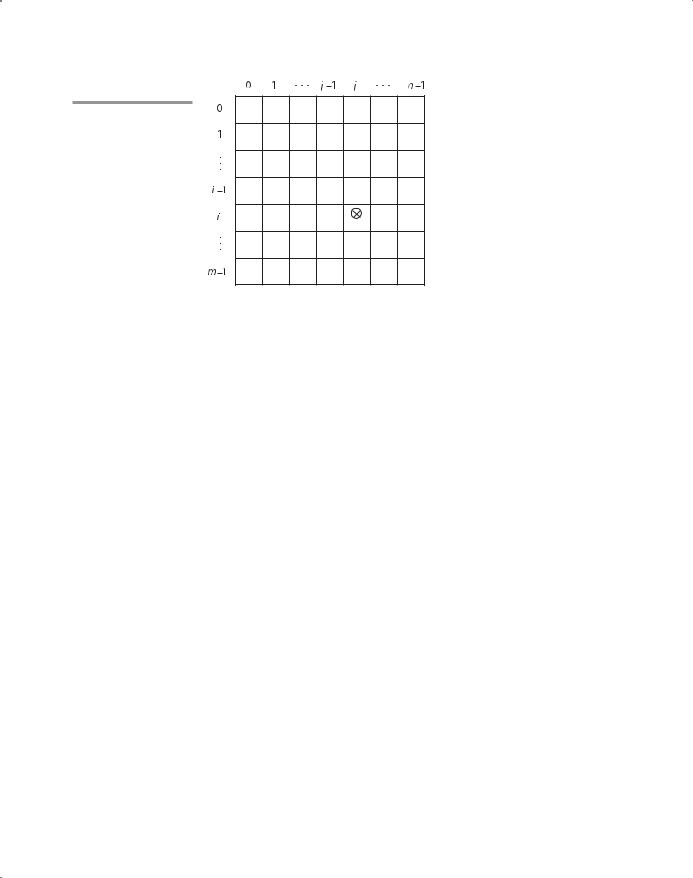
- •New to the Tenth Edition
- •Preface
- •Acknowledgments
- •About the Author
- •Contents
- •1.1 Reasons for Studying Concepts of Programming Languages
- •1.2 Programming Domains
- •1.3 Language Evaluation Criteria
- •1.4 Influences on Language Design
- •1.5 Language Categories
- •1.6 Language Design Trade-Offs
- •1.7 Implementation Methods
- •1.8 Programming Environments
- •Summary
- •Problem Set
- •2.1 Zuse’s Plankalkül
- •2.2 Pseudocodes
- •2.3 The IBM 704 and Fortran
- •2.4 Functional Programming: LISP
- •2.5 The First Step Toward Sophistication: ALGOL 60
- •2.6 Computerizing Business Records: COBOL
- •2.7 The Beginnings of Timesharing: BASIC
- •2.8 Everything for Everybody: PL/I
- •2.9 Two Early Dynamic Languages: APL and SNOBOL
- •2.10 The Beginnings of Data Abstraction: SIMULA 67
- •2.11 Orthogonal Design: ALGOL 68
- •2.12 Some Early Descendants of the ALGOLs
- •2.13 Programming Based on Logic: Prolog
- •2.14 History’s Largest Design Effort: Ada
- •2.15 Object-Oriented Programming: Smalltalk
- •2.16 Combining Imperative and Object-Oriented Features: C++
- •2.17 An Imperative-Based Object-Oriented Language: Java
- •2.18 Scripting Languages
- •2.19 The Flagship .NET Language: C#
- •2.20 Markup/Programming Hybrid Languages
- •Review Questions
- •Problem Set
- •Programming Exercises
- •3.1 Introduction
- •3.2 The General Problem of Describing Syntax
- •3.3 Formal Methods of Describing Syntax
- •3.4 Attribute Grammars
- •3.5 Describing the Meanings of Programs: Dynamic Semantics
- •Bibliographic Notes
- •Problem Set
- •4.1 Introduction
- •4.2 Lexical Analysis
- •4.3 The Parsing Problem
- •4.4 Recursive-Descent Parsing
- •4.5 Bottom-Up Parsing
- •Summary
- •Review Questions
- •Programming Exercises
- •5.1 Introduction
- •5.2 Names
- •5.3 Variables
- •5.4 The Concept of Binding
- •5.5 Scope
- •5.6 Scope and Lifetime
- •5.7 Referencing Environments
- •5.8 Named Constants
- •Review Questions
- •6.1 Introduction
- •6.2 Primitive Data Types
- •6.3 Character String Types
- •6.4 User-Defined Ordinal Types
- •6.5 Array Types
- •6.6 Associative Arrays
- •6.7 Record Types
- •6.8 Tuple Types
- •6.9 List Types
- •6.10 Union Types
- •6.11 Pointer and Reference Types
- •6.12 Type Checking
- •6.13 Strong Typing
- •6.14 Type Equivalence
- •6.15 Theory and Data Types
- •Bibliographic Notes
- •Programming Exercises
- •7.1 Introduction
- •7.2 Arithmetic Expressions
- •7.3 Overloaded Operators
- •7.4 Type Conversions
- •7.5 Relational and Boolean Expressions
- •7.6 Short-Circuit Evaluation
- •7.7 Assignment Statements
- •7.8 Mixed-Mode Assignment
- •Summary
- •Problem Set
- •Programming Exercises
- •8.1 Introduction
- •8.2 Selection Statements
- •8.3 Iterative Statements
- •8.4 Unconditional Branching
- •8.5 Guarded Commands
- •8.6 Conclusions
- •Programming Exercises
- •9.1 Introduction
- •9.2 Fundamentals of Subprograms
- •9.3 Design Issues for Subprograms
- •9.4 Local Referencing Environments
- •9.5 Parameter-Passing Methods
- •9.6 Parameters That Are Subprograms
- •9.7 Calling Subprograms Indirectly
- •9.8 Overloaded Subprograms
- •9.9 Generic Subprograms
- •9.10 Design Issues for Functions
- •9.11 User-Defined Overloaded Operators
- •9.12 Closures
- •9.13 Coroutines
- •Summary
- •Programming Exercises
- •10.1 The General Semantics of Calls and Returns
- •10.2 Implementing “Simple” Subprograms
- •10.3 Implementing Subprograms with Stack-Dynamic Local Variables
- •10.4 Nested Subprograms
- •10.5 Blocks
- •10.6 Implementing Dynamic Scoping
- •Problem Set
- •Programming Exercises
- •11.1 The Concept of Abstraction
- •11.2 Introduction to Data Abstraction
- •11.3 Design Issues for Abstract Data Types
- •11.4 Language Examples
- •11.5 Parameterized Abstract Data Types
- •11.6 Encapsulation Constructs
- •11.7 Naming Encapsulations
- •Summary
- •Review Questions
- •Programming Exercises
- •12.1 Introduction
- •12.2 Object-Oriented Programming
- •12.3 Design Issues for Object-Oriented Languages
- •12.4 Support for Object-Oriented Programming in Smalltalk
- •12.5 Support for Object-Oriented Programming in C++
- •12.6 Support for Object-Oriented Programming in Objective-C
- •12.7 Support for Object-Oriented Programming in Java
- •12.8 Support for Object-Oriented Programming in C#
- •12.9 Support for Object-Oriented Programming in Ada 95
- •12.10 Support for Object-Oriented Programming in Ruby
- •12.11 Implementation of Object-Oriented Constructs
- •Summary
- •Programming Exercises
- •13.1 Introduction
- •13.2 Introduction to Subprogram-Level Concurrency
- •13.3 Semaphores
- •13.4 Monitors
- •13.5 Message Passing
- •13.6 Ada Support for Concurrency
- •13.7 Java Threads
- •13.8 C# Threads
- •13.9 Concurrency in Functional Languages
- •13.10 Statement-Level Concurrency
- •Summary
- •Review Questions
- •Problem Set
- •14.1 Introduction to Exception Handling
- •14.2 Exception Handling in Ada
- •14.3 Exception Handling in C++
- •14.4 Exception Handling in Java
- •14.5 Introduction to Event Handling
- •14.6 Event Handling with Java
- •14.7 Event Handling in C#
- •Review Questions
- •Problem Set
- •15.1 Introduction
- •15.2 Mathematical Functions
- •15.3 Fundamentals of Functional Programming Languages
- •15.4 The First Functional Programming Language: LISP
- •15.5 An Introduction to Scheme
- •15.6 Common LISP
- •15.8 Haskell
- •15.10 Support for Functional Programming in Primarily Imperative Languages
- •15.11 A Comparison of Functional and Imperative Languages
- •Review Questions
- •Problem Set
- •16.1 Introduction
- •16.2 A Brief Introduction to Predicate Calculus
- •16.3 Predicate Calculus and Proving Theorems
- •16.4 An Overview of Logic Programming
- •16.5 The Origins of Prolog
- •16.6 The Basic Elements of Prolog
- •16.7 Deficiencies of Prolog
- •16.8 Applications of Logic Programming
- •Review Questions
- •Programming Exercises
- •Bibliography
- •Index

6.5 Array Types |
259 |
for the subtype, except assignment of values outside the specified range. For example, in
Day1 : Days;
Day2 : Weekdays;
...
Day2 := Day1;
the assignment is legal unless the value of Day1 is Sat or Sun.
The compiler must generate range-checking code for every assignment to a subrange variable. While types are checked for compatibility at compile time, subranges require run-time range checking.
One of the most common uses of user-defined ordinal types is for the indices of arrays, as will be discussed in Section 6.5. They can also be used for loop variables. In fact, subranges of ordinal types are the only way the range of Ada for loop variables can be specified.
6.4.2.2 Evaluation
Subrange types enhance readability by making it clear to readers that variables of subtypes can store only certain ranges of values. Reliability is increased with subrange types, because assigning a value to a subrange variable that is outside the specified range is detected as an error, either by the compiler (in the case of the assigned value being a literal value) or by the run-time system (in the case of a variable or expression). It is odd that no contemporary language except Ada has subrange types.
6.4.3Implementation of User-Defined Ordinal Types
As discussed earlier, enumeration types are usually implemented as integers. Without restrictions on ranges of values and operations, this provides no increase in reliability.
Subrange types are implemented in exactly the same way as their parent types, except that range checks must be implicitly included by the compiler in every assignment of a variable or expression to a subrange variable. This step increases code size and execution time, but is usually considered well worth the cost. Also, a good optimizing compiler can optimize away some of the checking.
6.5 Array Types
An array is a homogeneous aggregate of data elements in which an individual element is identified by its position in the aggregate, relative to the first element. The individual data elements of an array are of the same type. References to individual array elements are specified using subscript expressions. If any of the subscript expressions in a reference include variables, then the reference

260 |
Chapter 6 Data Types |
will require an additional run-time calculation to determine the address of the memory location being referenced.
In many languages, such as C, C++, Java, Ada, and C#, all of the elements of an array are required to be of the same type. In these languages, pointers and references are restricted to point to or reference a single type. So the objects or data values being pointed to or referenced are also of a single type. In some other languages, such as JavaScript, Python, and Ruby, variables are typeless references to objects or data values. In these cases, arrays still consist of elements of a single type, but the elements can reference objects or data values of different types. Such arrays are still homogeneous, because the array elements are of the same type.
C# and Java 5.0 provide generic arrays, that is, arrays whose elements are references to objects, through their class libraries. These are discussed in Section 6.5.3.
6.5.1Design Issues
The primary design issues specific to arrays are the following:
•What types are legal for subscripts?
•Are subscripting expressions in element references range checked?
•When are subscript ranges bound?
•When does array allocation take place?
•Are ragged or rectangular multidimensioned arrays allowed, or both?
•Can arrays be initialized when they have their storage allocated?
•What kinds of slices are allowed, if any?
In the following sections, examples of the design choices made for the arrays of the most common programming languages are discussed.
6.5.2Arrays and Indices
Specific elements of an array are referenced by means of a two-level syntactic mechanism, where the first part is the aggregate name, and the second part is a possibly dynamic selector consisting of one or more items known as subscripts or indices. If all of the subscripts in a reference are constants, the selector is static; otherwise, it is dynamic. The selection operation can be
histor y note |
thought of as a mapping from the array name and the set of sub- |
|
|
script values to an element in the aggregate. Indeed, arrays are |
|
|
||
The designers of pre-90 For- |
sometimes called finite mappings. Symbolically, this mapping |
|
trans and PL/I chose paren- |
can be shown as |
|
theses for array subscripts |
array_name(subscript_value_list) → element |
|
because no other suitable |
||
|
||
characters were available at |
The syntax of array references is fairly universal: The array |
|
the time. Card punches did not |
name is followed by the list of subscripts, which is surrounded |
|
include bracket characters. |
by either parentheses or brackets. In some languages that pro- |
|
|
vide multidimensioned arrays as arrays of arrays, each subscript |
|
|

6.5 Array Types |
261 |
appears in its own brackets. A problem with using parentheses to enclose subscript expressions is that they often are also used to enclose the parameters in subprogram calls; this use makes references to arrays appear exactly like those calls. For example, consider the following Ada assignment statement:
Sum := Sum + B(I);
Because parentheses are used for both subprogram parameters and array subscripts in Ada, both program readers and compilers are forced to use other information to determine whether B(I) in this assignment is a function call or a reference to an array element. This results in reduced readability.
The designers of Ada specifically chose parentheses to enclose subscripts so there would be uniformity between array references and function calls in expressions, in spite of potential readability problems. They made this choice in part because both array element references and function calls are mappings. Array element references map the subscripts to a particular element of the array. Function calls map the actual parameters to the function definition and, eventually, a functional value.
Most languages other than Fortran and Ada use brackets to delimit their array indices.
Two distinct types are involved in an array type: the element type and the type of the subscripts. The type of the subscripts is often a subrange of integers, but Ada allows any ordinal type to be used as subscripts, such as Boolean, character, and enumeration. For example, in Ada one could have the following:
type Week_Day_Type is (Monday, Tuesday, Wednesday,
Thursday, Friday);
type Sales is array (Week_Day_Type) of Float;
An Ada for loop can use any ordinal type variable for its counter, as we will see in Chapter 8. This allows arrays with ordinal type subscripts to be conveniently processed.
Early programming languages did not specify that subscript ranges must be implicitly checked. Range errors in subscripts are common in programs, so requiring range checking is an important factor in the reliability of languages. Many contemporary languages do not specify range checking of subscripts, but Java, ML, and C# do. By default, Ada checks the range of all subscripts, but this feature can be disabled by the programmer.
Subscripting in Perl is a bit unusual in that although the names of all arrays begin with at signs (@), because array elements are always scalars and the names of scalars always begin with dollar signs ($), references to array elements use dollar signs rather than at signs in their names. For example, for the array @list, the second element is referenced with $list[1].

262 |
Chapter 6 Data Types |
One can reference an array element in Perl with a negative subscript, in which case the subscript value is an offset from the end of the array. For example, if the array @list has five elements with the subscripts 0..4, $list[-2] references the element with the subscript 3. A reference to a nonexistent element in Perl yields undef, but no error is reported.
6.5.3Subscript Bindings and Array Categories
The binding of the subscript type to an array variable is usually static, but the subscript value ranges are sometimes dynamically bound.
In some languages, the lower bound of the subscript range is implicit. For example, in the C-based languages, the lower bound of all subscript ranges is fixed at 0; in Fortran 95+ it defaults to 1 but can be set to any integer literal. In some other languages, the lower bounds of the subscript ranges must be specified by the programmer.
There are five categories of arrays, based on the binding to subscript ranges, the binding to storage, and from where the storage is allocated. The category names indicate the design choices of these three. In the first four of these categories, once the subscript ranges are bound and the storage is allocated, they remain fixed for the lifetime of the variable. Keep in mind that when the subscript ranges are fixed, the array cannot change size.
A static array is one in which the subscript ranges are statically bound and storage allocation is static (done before run time). The advantage of static arrays is efficiency: No dynamic allocation or deallocation is required. The disadvantage is that the storage for the array is fixed for the entire execution time of the program.
A fixed stack-dynamic array is one in which the subscript ranges are statically bound, but the allocation is done at declaration elaboration time during execution. The advantage of fixed stack-dynamic arrays over static arrays is space efficiency. A large array in one subprogram can use the same space as a large array in a different subprogram, as long as both subprograms are not active at the same time. The same is true if the two arrays are in different blocks that are not active at the same time. The disadvantage is the required allocation and deallocation time.
A stack-dynamic array is one in which both the subscript ranges and the storage allocation are dynamically bound at elaboration time. Once the subscript ranges are bound and the storage is allocated, however, they remain fixed during the lifetime of the variable. The advantage of stack-dynamic arrays over static and fixed stack-dynamic arrays is flexibility. The size of an array need not be known until the array is about to be used.
A fixed heap-dynamic array is similar to a fixed stack-dynamic array, in that the subscript ranges and the storage binding are both fixed after storage is allocated. The differences are that both the subscript ranges and storage bindings are done when the user program requests them during execution, and the storage is allocated from the heap, rather than the stack. The advantage of fixed heap-dynamic arrays is flexibility—the array’s size always fits the problem. The disadvantage is allocation time from the heap, which is longer than allocation time from the stack.

6.5 Array Types |
263 |
A heap-dynamic array is one in which the binding of subscript ranges and storage allocation is dynamic and can change any number of times during the array’s lifetime. The advantage of heap-dynamic arrays over the others is flexibility: Arrays can grow and shrink during program execution as the need for space changes. The disadvantage is that allocation and deallocation take longer and may happen many times during execution of the program. Examples of the five categories are given in the following paragraphs.
Arrays declared in C and C++ functions that include the static modifier are static.
Arrays that are declared in C and C++ functions (without the static specifier) are examples of fixed stack-dynamic arrays.
Ada arrays can be stack dynamic, as in the following:
Get(List_Len);
declare
List : array (1..List_Len) of Integer;
begin
...
end;
In this example, the user inputs the number of desired elements for the array List. The elements are then dynamically allocated when execution reaches the declare block. When execution reaches the end of the block, the List array is deallocated.
C and C++ also provide fixed heap-dynamic arrays. The standard C library functions malloc and free, which are general heap allocation and deallocation operations, respectively, can be used for C arrays. C++ uses the operators new and delete to manage heap storage. An array is treated as a pointer to a collection of storage cells, where the pointer can be indexed, as discussed in Section 6.11.5.
In Java, all non-generic arrays are fixed heap-dynamic. Once created, these arrays keep the same subscript ranges and storage. C# also provides the same kind of arrays.
C# also provides generic heap-dynamic arrays, which are objects of the List class. These array objects are created without any elements, as in
List<String> stringList = new List<String>();
Elements are added to this object with the Add method, as in
stringList.Add("Michael");
Access to elements of these arrays is through subscripting.
Java includes a generic class similar to C#’s List, named ArrayList. It is different from C#’s List in that subscripting is not supported—get and set methods must be used to access the elements.

264 |
Chapter 6 Data Types |
A Perl array can be made to grow by using the push ( puts one or more new elements on the end of the array) and unshift ( puts one or more new elements on the beginning of the array), or by assigning a value to the array specifying a subscript beyond the highest current subscript of the array. An array can be made to shrink to no elements by assigning it the empty list, (). The length of an array is defined to be the largest subscript plus one.
Like Perl, JavaScript allows arrays to grow with the push and unshift methods and shrink by setting them to the empty list. However, negative subscripts are not supported.
JavaScript arrays can be sparse, meaning the subscript values need not be contiguous. For example, suppose we have an array named list that has 10 elements with the subscripts 0..9.5 Consider the following assignment statement:
list[50] = 42;
Now, list has 11 elements and length 51. The elements with subscripts 11..49 are not defined and therefore do not require storage. A reference to a nonexistent element in a JavaScript array yields undefined.
Arrays in Python, Ruby, and Lua can be made to grow only through methods to add elements or catenate other arrays. Ruby and Lua support negative subscripts, but Python does not. In Python, Ruby, and Lua an element or slice of an array can be deleted. A reference to a nonexistent element in Python results in a run-time error, whereas a similar reference in Ruby and Lua yields nil and no error is reported.
Although the ML definition does not include arrays, its widely used implementation, SML/NJ, does.
The only predefined collection type that is part of F# is the array (other collection types are provided through the .NET Framework Library). These arrays are like those of C#. A foreach statement is included in the language for array processing.
6.5.4Array Initialization
Some languages provide the means to initialize arrays at the time their storage is allocated. In Fortran 95+, an array can be initialized by assigning it an array aggregate in its declaration. An array aggregate for a single-dimensioned array is a list of literals delimited by parentheses and slashes. For example, we could have
Integer, Dimension (3) :: List = (/0, 5, 5/)
C, C++, Java, and C# also allow initialization of their arrays, but with one new twist: In the C declaration
int list [] = {4, 5, 7, 83};
5. The subscript range could just as easily have been 1000 . . 1009.

6.5 Array Types |
265 |
the compiler sets the length of the array. This is meant to be a convenience but is not without cost. It effectively removes the possibility that the system could detect some kinds of programmer errors, such as mistakenly leaving a value out of the list.
As discussed in Section 6.3.2, character strings in C and C++ are implemented as arrays of char. These arrays can be initialized to string constants, as in
char name [] = "freddie";
The array name will have eight elements, because all strings are terminated with a null character (zero), which is implicitly supplied by the system for string constants.
Arrays of strings in C and C++ can also be initialized with string literals. In this case, the array is one of pointers to characters. For example,
char *names [] = {"Bob", "Jake", "Darcie"};
This example illustrates the nature of character literals in C and C++. In the previous example of a string literal being used to initialize the char array name, the literal is taken to be a char array. But in the latter example (names), the literals are taken to be pointers to characters, so the array is an array of pointers to characters. For example, names[0] is a pointer to the letter 'B' in the literal character array that contains the characters 'B', 'o', 'b', and the null character.
In Java, similar syntax is used to define and initialize an array of references to String objects. For example,
String[] names = ["Bob", "Jake", "Darcie"];
Ada provides two mechanisms for initializing arrays in the declaration statement: by listing them in the order in which they are to be stored, or by directly assigning them to an index position using the => operator, which in Ada is called an arrow. For example, consider the following:
List : array (1..5) of Integer := (1, 3, 5, 7, 9);
Bunch : array (1..5) of Integer := (1 => 17, 3 => 34,
others => 0);
In the first statement, all the elements of the array List have initializing values, which are assigned to the array element locations in the order in which they appear. In the second, the first and third array elements are initialized using direct assignment, and the others clause is used to initialize the remaining elements. As with Fortran, these parenthesized lists of values are called aggregate values.

266 |
Chapter 6 Data Types |
6.5.5Array Operations
An array operation is one that operates on an array as a unit. The most common array operations are assignment, catenation, comparison for equality and inequality, and slices, which are discussed separately in Section 6.5.5.
The C-based languages do not provide any array operations, except through the methods of Java, C++, and C#. Perl supports array assignments but does not support comparisons.
Ada allows array assignments, including those where the right side is an aggregate value rather than an array name. Ada also provides catenation, specified by the ampersand (&). Catenation is defined between two singledimensioned arrays and between a single-dimensioned array and a scalar. Nearly all types in Ada have the built-in relational operators for equality and inequality.
Python’s arrays are called lists, although they have all the characteristics of dynamic arrays. Because the objects can be of any types, these arrays are heterogeneous. Python provides array assignment, although it is only a reference change. Python also has operations for array catenation (+) and element membership (in). It includes two different comparison operators: one that determines whether the two variables reference the same object (is) and one that compares all corresponding objects in the referenced objects, regardless of how deeply they are nested, for equality (==).
Like Python, the elements of Ruby’s arrays are references to objects. And like Python, when a == operator is used between two arrays, the result is true only if the two arrays have the same length and the corresponding elements are equal. Ruby’s arrays can be catenated with an Array method.
Fortran 95+ includes a number of array operations that are called elemental because they are operations between pairs of array elements. For example, the add operator (+) between two arrays results in an array of the sums of the element pairs of the two arrays. The assignment, arithmetic, relational, and logical operators are all overloaded for arrays of any size or shape. Fortran 95+ also includes intrinsic, or library, functions for matrix multiplication, matrix transpose, and vector dot product.
F# includes many array operators in its Array module. Among these are
Array.append, Array.copy, and Array.length.
Arrays and their operations are the heart of APL; it is the most powerful array-processing language ever devised. Because of its relative obscurity and its lack of effect on subsequent languages, however, we present here only a glimpse into its array operations.
In APL, the four basic arithmetic operations are defined for vectors (single-dimensioned arrays) and matrices, as well as scalar operands. For example,
A + B
is a valid expression, whether A and B are scalar variables, vectors, or matrices.

6.5 Array Types |
267 |
APL includes a collection of unary operators for vectors and matrices, some of which are as follows (where V is a vector and M is a matrix):
V reverses the elements of VM reverses the columns of MM reverses the rows of M
o\M transposes M (its rows become its columns and vice versa) ÷M inverts M
APL also includes several special operators that take other operators as operands. One of these is the inner product operator, which is specified with a period (.). It takes two operands, which are binary operators. For example,
+.×
is a new operator that takes two arguments, either vectors or matrices. It first multiplies the corresponding elements of two arguments, and then it sums the results. For example, if A and B are vectors,
A × B
is the mathematical inner product of A and B (a vector of the products of the corresponding elements of A and B). The statement
A +.× B
is the sum of the inner product of A and B. If A and B are matrices, this expression specifies the matrix multiplication of A and B.
The special operators of APL are actually functional forms, which are described in Chapter 15.
6.5.6Rectangular and Jagged Arrays
A rectangular array is a multidimensioned array in which all of the rows have the same number of elements and all of the columns have the same number of elements. Rectangular arrays model rectangular tables exactly.
A jagged array is one in which the lengths of the rows need not be the same. For example, a jagged matrix may consist of three rows, one with 5 elements, one with 7 elements, and one with 12 elements. This also applies to the columns and higher dimensions. So, if there is a third dimension (layers), each layer can have a different number of elements. Jagged arrays are made possible when multidimensioned arrays are actually arrays of arrays. For example, a matrix would appear as an array of single-dimensioned arrays.
C, C++, and Java support jagged arrays but not rectangular arrays. In those languages, a reference to an element of a multidimensioned array uses a separate pair of brackets for each dimension. For example,
myArray[3][7]

268 |
Chapter 6 Data Types |
Fortran, Ada, C#, and F# support rectangular arrays. (C# and F# also support jagged arrays.) In these cases, all subscript expressions in references to elements are placed in a single pair of brackets. For example,
myArray[3, 7]
6.5.7Slices
A slice of an array is some substructure of that array. For example, if A is a matrix, then the first row of A is one possible slice, as are the last row and the first column. It is important to realize that a slice is not a new data type. Rather, it is a mechanism for referencing part of an array as a unit. If arrays cannot be manipulated as units in a language, that language has no use for slices.
Consider the following Python declarations:
vector = [2, 4, 6, 8, 10, 12, 14, 16]
mat = [[1, 2, 3],[4, 5, 6],[7, 8, 9]]
Recall that the default lower bound for Python arrays is 0. The syntax of a Python slice reference is a pair of numeric expressions separated by a colon. The first is the first subscript of the slice; the second is the first subscript after the last subscript in the slice. Therefore, vector[3:6] is a three-element array with the fourth through sixth elements of vector (those elements with the subscripts 3, 4, and 5). A row of a matrix is specified by giving just one subscript. For example, mat[1] refers to the second row of mat; a part of a row can be specified with the same syntax as a part of a single dimensioned array. For example, mat[0][0:2] refers to the first and second element of the first row of mat, which is [1, 2].
Python also supports more complex slices of arrays. For example, vector[0:7:2] references every other element of vector, up to but not including the element with the subscript 7, starting with the subscript 0, which is
[2, 6, 10, 14].
Perl supports slices of two forms, a list of specific subscripts or a range of subscripts. For example,
@list[1..5] = @list2[3, 5, 7, 9, 13];
Notice that slice references use array names, not scalar names, because slices are arrays (not scalars).
Ruby supports slices with the slice method of its Array object, which can take three forms of parameters. A single integer expression parameter is interpreted as a subscript, in which case slice returns the element with the given subscript. If slice is given two integer expression parameters, the first is interpreted as a beginning subscript and the second is interpreted as the number of elements in the slice. For example, suppose list is defined as follows:
list = [2, 4, 6, 8, 10]

6.5 Array Types |
269 |
list.slice(2, 2) returns [6, 8]. The third parameter form for slice is a range, which has the form of an integer expression, two periods, and a second integer expression. With a range parameter, slice returns an array of the element with the given range of subscripts. For example, list.slice (1..3) returns [4, 6, 8].
6.5.8Evaluation
Arrays have been included in virtually all programming languages. The primary advances since their introduction in Fortran I have been the inclusion of all ordinal types as possible subscript types, slices, and, of course, dynamic arrays. As discussed in Section 6.6, the latest advances in arrays have been in associative arrays.
6.5.9Implementation of Array Types
Implementing arrays requires considerably more compile-time effort than does implementing primitive types. The code to allow accessing of array elements must be generated at compile time. At run time, this code must be executed to produce element addresses. There is no way to precompute the address to be accessed by a reference such as
list[k]
A single-dimensioned array is implemented as a list of adjacent memory cells. Suppose the array list is defined to have a subscript range lower bound of 0. The access function for list is often of the form
address(list[k]) = address(list[0]) + k * element_size
where the first operand of the addition is the constant part of the access function, and the second is the variable part.
If the element type is statically bound and the array is statically bound to storage, then the value of the constant part can be computed before run time. However, the addition and multiplication operations must be done at run time.
The generalization of this access function for an arbitrary lower bound is
address(list[k]) = address(list[lower_bound]) +
((k - lower_bound) * element_size)
The compile-time descriptor for single-dimensioned arrays can have the form shown in Figure 6.4. The descriptor includes information required to construct the access function. If run-time checking of index ranges is not done and the attributes are all static, then only the access function is required during execution; no descriptor is needed. If run-time checking of index ranges is done, then those index ranges may need to be stored in a run-time descriptor. If the subscript ranges of a particular array type are static, then the ranges may be

270 |
Chapter 6 Data Types |
||
Figure 6.4 |
|
|
|
|
|
Array |
|
|
|
|
|
Compile-time descriptor |
|
Element type |
|
for single-dimensioned |
|
||
|
|
||
arrays |
|
|
Index type |
|
|
|
|
|
|
|
|
|
|
|
Index lower bound |
|
|
|
|
|
|
|
Index upper bound |
|
|
|
|
|
|
|
Address |
|
|
|
|
incorporated into the code that does the checking, thus eliminating the need for the run-time descriptor. If any of the descriptor entries are dynamically bound, then those parts of the descriptor must be maintained at run time.
True multidimensional arrays, that is, those that are not arrays of arrays, are more complex to implement than single-dimensioned arrays, although the extension to more dimensions is straightforward. Hardware memory is linear— it is usually a simple sequence of bytes. So values of data types that have two or more dimensions must be mapped onto the single-dimensioned memory. There are two ways in which multidimensional arrays can be mapped to one dimension: row major order and column major order. In row major order, the elements of the array that have as their first subscript the lower bound value of that subscript are stored first, followed by the elements of the second value of the first subscript, and so forth. If the array is a matrix, it is stored by rows. For example, if the matrix had the values
3 |
4 |
7 |
6 |
2 |
5 |
1 |
3 |
8 |
it would be stored in row major order as
3, 4, 7, 6, 2, 5, 1, 3, 8
In column major order, the elements of an array that have as their last subscript the lower bound value of that subscript are stored first, followed by the elements of the second value of the last subscript, and so forth. If the array is a matrix, it is stored by columns. If the example matrix were stored in column major order, it would have the following order in memory:
3, 6, 1, 4, 2, 3, 7, 5, 8
Column major order is used in Fortran, but other languages that have true multidimensional arrays use row major order.
The access function for a multidimensional array is the mapping of its base address and a set of index values to the address in memory of the element specified by the index values. The access function for two-dimensional arrays stored in row major order can be developed as follows. In general, the address

6.5 Array Types |
271 |
Figure 6.5
The location of the [i,j] element in a matrix
of an element is the base address of the structure plus the element size times the number of elements that precede it in the structure. For a matrix in row major order, the number of elements that precedes an element is the number of rows above the element times the size of a row, plus the number of elements to the left of the element. This is illustrated in Figure 6.5, in which we assume that subscript lower bounds are all zero.
To get an actual address value, the number of elements that precede the desired element must be multiplied by the element size. Now, the access function can be written as
location(a[i,j]) = address of a[0, 0]
+((((number of rows above the ith row) * (size of a row))
+(number of elements left of the jth column)) *
element size)
Because the number of rows above the ith row is i and the number of elements to the left of the jth column is j, we have
location(a[i, j]) = address of a[0, 0] + (((i * n) + j) * element_size)
where n is the number of elements per row. The first term is the constant part and the last is the variable part.
The generalization to arbitrary lower bounds results in the following access function:
location(a[i, j]) = address of a[row_lb, col_lb]
+ (((i - row_lb) * n) + (j - col_lb)) * element_size
where row_lb is the lower bound of the rows and col_lb is the lower bound of the columns. This can be rearranged to the form
